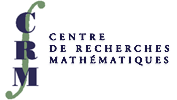 |
|
||||
Org: Zhiguo Hu and Mehdi Monfared (Windsor)
[PDF]
- YEMON CHOI, Université Laval
Convolution operators with empty residual spectrum [PDF] -
Let X be a Banach space on which a discrete group G acts by isometries. For certain natural choices of X, every element of the group algebra, when regarded as an operator on X, has empty residual spectrum. This turns out to be the case when X is l2(G) or the group von Neumann algebra VN(G), regardless of the choice of group. On the other hand, when X=l1(G), an example of Willis shows that some condition on G is necessary.
In this talk I will discuss some of these results, using the notion of a surjunctive pair to try and develop a systematic picture. If time permits I will mention some partial results that can be obtained for X = lp(G) when G is amenable; these rely on a majorization result of Herz.
- BRIAN E. FORREST, University of Waterloo
Multipliers of the Fourier Algebra, Ideals and an Extension Property [PDF] -
In this talk we will focus on some results concerning the multipliers and the completely bounded multipliers of A(G). In particular, we will show amongst other things that there exits ideals in A(F2) which are complemented, but not even weakly completely complemented. This answers a question raised previously by Peter Wood. Furthermore, when H is a closed subgroup of G, we can use this to shed light on the problem of extending functions in AM(H).
This is joint work with Michael Brannan and Cameron Zwarich.
- FEREIDOUN GHAHRAMANI, Department of Mathematics, University of Manitoba, Winnipeg R3T 2N2
Approximate amenability of Schatten classes, Lipschitz algebras and Segal algebras [PDF] -
In this talk I will present a criterion that can be used to show that neither of the Schatten operator ideals, Lipschitz algebras, or certain Segal algebras on locally compact groups is approximately amenable. This answers two open questions which Rick Loy and I raised in around 2003.
This is joint work with Yemon Choi.
- COLIN C. GRAHAM, UBC, Vancouver
A half new characterization of I0 sets [PDF] -
In 1966 Kahane gave a condition that implied a set is I0. That condition is also (the new half of the characterization) implied by "I0-ness". The proof of the new assertion uses a lemma (which might be of independent interest): there are constants 0 < cN such that the Haar measure of Çn=1N {g: |ág,xn ñ- 1| < e} is at least cN eN; the cN are independent of the xn and the LCA group involved.
This comes from joint work with Kathryn Hare.
- KATHRYN E. HARE, University of Waterloo
Determining the `size' of orbital measures on compact, simple Lie groups [PDF] -
Orbital measures are the uniform measures supported on conjugacy classes in the Lie group G. They are always singular measures and are continuous provided the conjugacy class is non-trivial. These measures satisfy a striking L2-singular dichotomy: Either mk Î L2 or mk is singular to Haar measure on G. In this talk we will discuss how the Weyl character formula and other ideas from Lie theory are used to determine the index where the change occurs.
- WOJCIECH JAWORSKI, Carleton University
Distal properties of totally disconnected locally compact groups of polynomial growth and certain ideals in group algebras [PDF] -
Given a locally compact group G let J(G) denote the set of closed left ideals in L1(G), of the form Jm = [L1(G)*(de -m)] [` ] where m is a probability measure on G. Given a closed subgroup H of G let L10(G,H) denote the kernel of the canonical mapping from L1(G) to L1(G/H). When G is totally disconnected and has polynomial growth, we prove that the following conditions are equivalent:
(i) J(G) = {L10(G,H); H is a closed subgroup of G};
(ii) the group of inner automorphisms of G acts distally on G ;
(iii) every inner automorphism of G is distal;
(iv) the contraction subgroup of every inner automorphism of G is trivial;
(v) G is a SIN group.This is a joint work with C. R. E. Raja.
- MEHDI MONFARED, University of Windsor, Windsor, ON
On finite-dimensional left ideals in the double dual of some Banach algebras [PDF] -
Given a finite-dimensional representation p of a Banach algebra A, we discuss the role of p-invariant elements in A" in determination of finite-dimensional left ideals in A".
- CHI-KEUNG NG, Nankai University, Tianjin, China
Linear orthogonality preservers of Hilbert C*-modules over general C*-algebras [PDF] -
In this talk, we discuss to what extent, the orthogonality structure of a Hilbert C*-module determines its C*-valued inner product.
- ZHONG-JIN RUAN, University of Illinois at Urbana-Champaign
p-Approximation Properties of PFp(G) and PMp(G) [PDF] -
Let 1 < p < ¥. We discuss various approximation properties of the pseudofunction algebras PFp(G) and the pseudomeasure algebras PMp(G) in the category of p-operator spaces. More precisely, we show that a discrete group G is p-weakly amenable if and only if PFp(G) has the p-completely bounded approximation property (respectively, PMp(G) has weak* continuous p-completely bounded approximation property). We also show that a discrete group G has the p-AP if and only if PFp(G) has the p-OAP (respectively, PMp(G) has the weak* p-OAP). These results generalize the work of Haagerup and Kraus to the general case of 1 < p < ¥.
This is a joint work with Jung Jin Lee.
- EBRAHIM SAMEI, University of Saskatchewan
The similairty problem for Fourier algebras and corepresentations of the group von Neumann algebras [PDF] -
Let G be a locally compact group, let A(G) be the Fourier algebra of G, and let VN(G) be the von Neumann algebra generated by the left regular representation of G. We study the similarity problem for A(G), i.e., whether every bounded representation of A(G) on a Hilbert space H is similar to a *-representation. We show that the answer is affirmative if G is a SIN-group and we consider completely bounded representations.
We apply these results to classify the corepresentations of VN(G) for large classes of groups including SIN-groups, maximally almost periodic groups, and totally disconnected groups. This partially answers a question of Effros and Ruan.
This is a joint work with Michael Brannan (Queen's University).
- NICO SPRONK, University of Waterloo, 200 University Ave W, Waterloo, ON N2L 3G1
Symmetry of Beurling-Fourier algebras on compact groups [PDF] -
For a compact group G, I will define the Beurling-Fourier algebras Awp(G) on G, for weights w: [^(G)] ® R > 0 and 1 £ p £ ¥. The classical Fourier algebra of G corresponds to the case p=1 and w is the constant weight 1; when G=T, Awp(G) = l1 (Z,w), the classical Beurling algebra on Z. To define the spectrum of G, we require development of an abstract Lie theory which is built from Krein-Tannaka duality, and was formalized separately by McKennon, and Cartwright and McMullen, in the 1970s. This Lie theory allows us for any to develop the complexification GC, even for non-Lie G. The Gelfand spectrum SAwp(G) can always be realized as a subset of GC.
I will consider the following question: When is SAwp(G) symmetric? I will present evidence towards the following conjecture. The algebra Awp(G) is symmetric if and only if the weight w is subexponential (in which case SAwp(G) @ G).
This is part of joint work, in progress, with J. Ludwig and L. Turowska.





